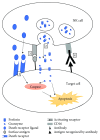Effect of Natural Compounds on NK Cell Activation
- PMID: 30671486
- PMCID: PMC6323526
- DOI: 10.1155/2018/4868417
Effect of Natural Compounds on NK Cell Activation
Abstract
Natural killer (NK) cells are lymphocytes of the innate immune system that survey the body for stressed and abnormal cells. The integration of signals that they receive through various inhibitory and activating cell surface receptors controls their activation and ability to kill target cells and produce cytokines. In this manner, phenotypically and functionally distinct subsets of NK cells help protect against microbial infections and cancer and shape the adaptive immune response. NK cells can use two different mechanisms to kill their targets, either by cytotoxic granule exocytosis or by induction of death receptor-mediated apoptosis. Death ligands belong to the tumor necrosis factor (TNF) family of ligands. Upon release in close proximity to a cell slated for killing, perforin forms pores in the cell membrane of the target cell through which granzymes and associated molecules can enter and induce apoptosis. NK cells are also involved in antibody-dependent cellular toxicity via the CD16 receptor. In addition to target recognition, NK cells can be also activated by treatment with multiple compounds with stimulatory properties. Apart from interleukins, which belong to the best characterized group of NK cell-stimulating compounds, vitamins and constituents extracted from plants also display the ability to activate NK cells. The current review characterizes several groups of NK cell-activating compounds: vitamins belonging to classes A, B, C, D, and E, polysaccharides, lectins, and a number of phytochemicals used in cancer research, exhibiting stimulatory properties when applied to NK cells. Although in most cases the exact mechanism of action is not known, constituents described in this review seem to be promising candidates for NK cell-stimulating drugs.
Figures


References
Publication types
MeSH terms
Substances
LinkOut - more resources
Full Text Sources

